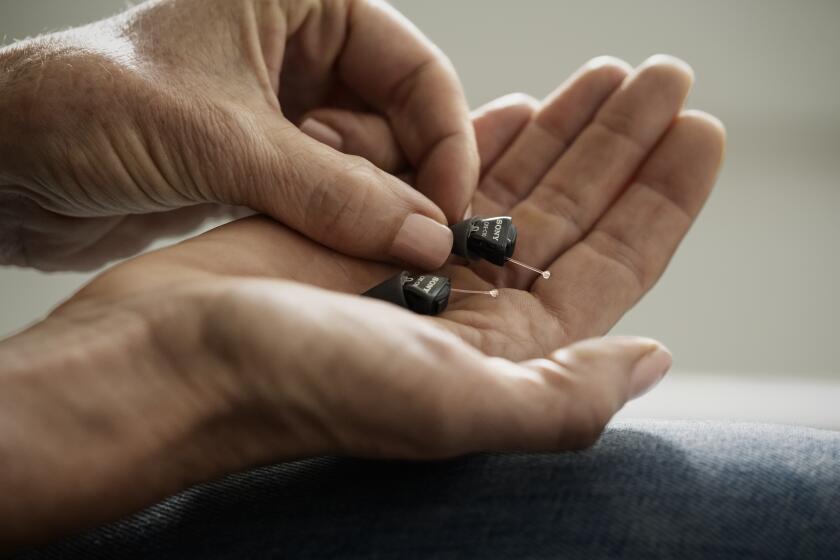Drug Therapy for Parkinson’s Proves Effective
A nationwide clinical trial of a new drug therapy for Parkinson’s disease has been stopped early so that researchers can begin giving the drug, which has “striking beneficial effects,” to all 800 subjects in the trial.
The physicians conducting the study said Wednesday that neurologists should begin routinely administering the drug, called deprenyl, to all newly diagnosed Parkinson’s victims, an estimated 60,000 people per year in the United States.
Preliminary results from the clinical trial, reported today in the New England Journal of Medicine, indicate that deprenyl can nearly double the amount of time that elapses between the diagnosis of Parkinson’s and the need for therapy with the most commonly used Parkinson’s drug, L-dopa. Deprenyl also allowed Parkinson’s victims to remain employed full-time for longer periods.
“This is a very valuable piece of research that gives important new information about delaying the progression of early Parkinsonism,” said neurologist Carl Leventhal of the National Institute of Neurological and Communicative Diseases and Stroke, which sponsored the study.
“I think we’ve got one hell of a drug here,” said Judy Rosner, executive director of the United Parkinson Foundation in Chicago. “It’s the first drug that may slow the progression of a chronic neurologic disorder.”
Parkinson’s affects as many as 1 million people nationwide, most of them over the age of 50. It is caused by the death of brain cells that secrete the neurotransmitter dopamine, which plays a key role in the control of muscle movement.
As these cells die, victims develop symptoms that include disabling tremors and rigidity of the limbs. At least 30% of its victims also suffer mental impairment.
L-dopa, which is converted into dopamine in the brain, relieves the symptoms of the disease, but does not halt its progression. L-dopa can also have severe side effects, including jerking movements more severe than those caused by the disease, irregularities of heartbeat and mental impairment.
In June, the Food and Drug Administration approved the marketing of deprenyl for use in combination with L-dopa to reduce those side effects in patients late in the course of the disease. Somerset Pharmaceuticals of Denville, N.J., began marketing the drug as Eldepryl in mid-September, and physicians are free to prescribe it for use earlier in the disease’s progression.
The estimated cost of deprenyl is $1,200 to $1,500 per year.
Today’s report follows a preliminary study conducted by neurologists J. William Langston and James W. Tetrud of the California Parkinson’s Foundation in San Jose that suggested deprenyl is highly effective. In their study of 54 people who had recently been diagnosed as having Parkinson’s, half received deprenyl daily and half received a placebo--a sugar pill with no effect.
Langston and Tetrud reported in August that the patients receiving placebo required L-dopa an average of 312 days after the diagnosis of Parkinson’s, while those who received deprenyl did not require it until 549 days after diagnosis.
The results reported today are very similar to those of Langston and Tetrud, but they involved a much larger number of patients, according to neurologist Ira Shoulson of the University of Rochester Medical Center, co-chairman of the Parkinson Study Group, a consortium of 34 investigators from 28 medical centers in the United States and Canada. Between September, 1987, and November, 1988, 800 patients were enrolled in the consortium’s so-called DATATOP study.
DATATOP was actually designed to study two different drugs, deprenyl and tocopherol (vitamin E). Researchers believed that either or both of the drugs could slow the deterioration of the dopamine-secreting brain cells and thereby delay the progression of the disease. The subjects were divided into four groups: one received placebo, one received only tocopherol daily, one received only deprenyl daily and one received both deprenyl and tocopherol.
At the beginning of the study in 1987, the researchers also set up an independent safety monitoring committee whose primary purpose was to watch for adverse side effects of the drugs. In February--about 3 1/2 years before the study was scheduled to end--that group notified the committee chairmen of “a striking beneficial trend in the data,” Shoulson said in a telephone interview. “That prompted an in-depth analysis of the preliminary results” and a premature termination of the study.
The analysis showed that, among the 399 patients who received deprenyl, only 97 had to begin taking L-dopa within 12 months. Among the 401 patients who did not receive deprenyl, 176 had to begin using L-dopa within 12 months.
Put in another way, the risk of having symptoms severe enough to require L-dopa was reduced by 57% among patients receiving deprenyl. Furthermore, Shoulson said, the side effects of the drug were “negligible.” All the subjects enrolled in the trial were notified of the preliminary results this summer and began receiving deprenyl.
These results, combined with the August findings, “will alter the way we treat Parkinson’s not only in the United States, but around the world,” Langston said.
The preliminary data is not yet sufficient to show any beneficial effect of vitamin E, Shoulson added, so that portion of the trial will continue. The researchers will also continue to monitor all the patients to determine whether the combined effects of deprenyl and L-dopa are greater than those of L-dopa alone. Some anecdotal European studies have shown that deprenyl used with L-dopa prolongs the life span of Parkinson’s victims.
Shoulson cautioned that researchers have not yet proved that deprenyl actually slows the degeneration of brain cells, a process that would require brain surgery to physically examine the cells.
At a Wednesday press conference in New York City, he also cautioned that the drug is not a cure. “Parkinson patients and families have heard about this and they read into it that this is a miracle drug and it’s going to stop the disease,” he said. “It’s a useful drug, but it is not a miracle drug.”



